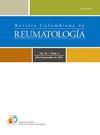Características sociodemográficas, clínicas y bioquímicas de pacientes que debutaron con y sin nefritis lúpica en una cohorte de pacientes mexicanos con lupus eritematoso sistémico en un centro de referencia
Q3 Health Professions
引用次数: 0
Abstract
Introduction
Systemic lupus erythematosus (SLE) is an autoimmune inflammatory disease that presents great clinical heterogeneity, so that up to 60% of patients may develop lupus nephropathy (LN).
Objective
To identify demographic, clinical, and biochemical characteristics of patients presenting with and without lupus nephritis at the time of SLE diagnosis in a cohort of Mexican patients.
Materials and methods
This is a cross-sectional, analytical, and single-centre study. Frequencies and percentages were used for categorical variables and the comparison was made with Pearson's Chi2 statistical test or Fisher's exact test. For the quantitative variables, their distribution was calculated and according to this, Student's t was used in case of normal distribution and Mann-Whitney U for those with free distribution.
Results
Of 160 patients, 79 (49.37%) had LN. These individuals had a higher prevalence of serositis (14.3 vs 8.1%, p = .048) and arterial hypertension (40.50% vs 24.6%, p = .033), while those without LN had a higher prevalence of rheumatoid arthritis and joint disease (6 vs 1%, p = .052), allergies (43.2 vs 20.25%, p = .002), infections (23.45 vs 10%, p = .020), and lower levels of C3 (52.25 ± 28.7 vs 74.6 ± 32.2 mg/dl, p < .001).
Conclusions
The characteristics described in our cohort are like those presented in other Latino and Asian series. However, the presence of concomitant infections at the time of SLE diagnosis has not been described and should be considered for future research.
一家转诊中心的墨西哥系统性红斑狼疮患者队列中狼疮性肾炎和非狼疮性肾炎患者的社会人口学、临床和生化特征。
系统性红斑狼疮(SLE)是一种自身免疫性炎症性疾病,具有很大的临床异质性,因此高达60%的患者可发展为狼疮肾病(LN)。目的在一组墨西哥患者中,确定SLE诊断时伴有和不伴有狼疮性肾炎患者的人口学、临床和生化特征。材料和方法这是一项横断面、分析性、单中心研究。分类变量采用频率和百分比,采用Pearson's Chi2统计检验或Fisher's精确检验进行比较。对于定量变量,计算其分布,在正态分布情况下使用Student’st,在自由分布情况下使用Mann-Whitney U。结果160例患者中有79例(49.37%)发生LN。这些人有较高的血清炎患病率(14.3 vs 8.1%, p = 0.048)和动脉高血压患病率(40.50% vs 24.6%, p = 0.033),而那些没有LN的人有较高的类风湿关节炎和关节疾病患病率(6 vs 1%, p = 0.052)、过敏(43.2 vs 20.25%, p = 0.002)、感染(23.45 vs 10%, p = 0.020)和较低的C3水平(52.25±28.7 vs 74.6±32.2 mg/dl, p <;措施)。结论:在我们的队列中描述的特征与其他拉丁美洲和亚洲系列的特征相似。然而,在SLE诊断时是否存在合并感染尚未被描述,应在未来的研究中予以考虑。
本文章由计算机程序翻译,如有差异,请以英文原文为准。
求助全文
约1分钟内获得全文
求助全文
来源期刊

Revista Colombiana de Reumatologia
Medicine-Rheumatology
CiteScore
0.80
自引率
0.00%
发文量
92
期刊介绍:
The Colombian Journal of Rheumatology (Revista Colombiana de Reumatología) is the official organ of the Colombian Association of Rheumatology (Asociación Colombiana de Reumatología) and the Central American, Caribbean and Andean Association of Rheumatology (Asociación Centroamericana Caribe Andina de Reumatología) - ACCA. It was created in December 1993 with the purpose of disseminating scientific information derived from primary and secondary research and presenting cases coming from the practice of Rheumatology in Latin America. Since its foundation, the Journal has been characterized by its plurality with subjects of all rheumatic and osteomuscular pathologies, in the form of original articles, historical articles, economic evaluations, and articles of reflection and education in Medicine. It covers an extensive area of topics ranging from the broad spectrum of the clinical aspects of rheumatology and related areas in autoimmunity (both in pediatric and adult pathologies), to aspects of basic sciences. It is an academic tool for the different members of the academic and scientific community at their different levels of training, from undergraduate to post-doctoral degrees, managing to integrate all actors inter and trans disciplinarily. It is intended for rheumatologists, general internists, specialists in related areas, and general practitioners in the country and abroad. It has become an important space in the work of all rheumatologists from Central and South America.
 求助内容:
求助内容: 应助结果提醒方式:
应助结果提醒方式:


